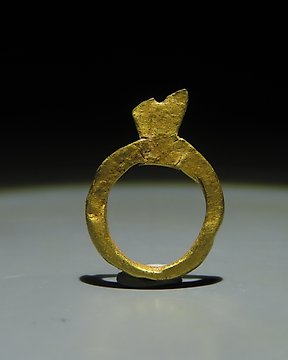
Anatolien Or Bague idole. 3500-2500 avant JC. Hauteur. 2 cm.
Nº 84860717

Nº 84860717

Necklace
- gold -
- intact -
CULTURE: Tairona, Colombia
PERIOD: c. 1000 - 1500 AD
MATERIAL: Rock crystal and Tumbaga (alloy of gold and copper)
DIMENSIONS: 36 cm in total length
PROVENANCE: Private collection, Paris, France (1960-1970). With Spanish Export License.
CONDITION: Intact. Good state.
DESCRIPTION:
The gold ornaments created by the Tairona people of the Sierra Nevada de Santa Marta (in northern Colombia) are among the most spectacular and complex objects made on the American continent. This voluminous, three-dimensional pendant depicts a broad-shouldered male figure, perhaps a nobleman or chieftain, wearing a massive plume of elaborately braided elements.
Although the Tairona are still today an important indigenous group in Colombia, their culture is as yet little known. In 1976 the Ciudad Perdida was found, which had been built by the Tairona in the year 800 and had been inhabited until 1600 AD. However, their use of materials in their culture is known and their working of gold was particularly of note. The Tairona people developed techniques like that of lost-wax casting, alloys like tumbaga, that allowed them to work with greater ease with gold, and treatments to improve the quality of this material, such as heating it until the copper oxidises and then plunging it into very cold water to obtain a permanent gold patina and to prevent cracking.
The working of metals appeared in Colombian regions towards the 6th Century BC when societies which had artisans skilled in working metals lived on the Pacific coast. During the two thousand years of development of metal working in Colombia, interrupted by the Spanish conquest in 1500 AD, a dozen different styles emerged, combining different techniques on diverse alloys and producing great quantities of exceptional quality. These were notable for their equilibrium and composition which give the Pre-Hispanic working of metals in Colombia an outstanding place in world art. The main themes seen are the human figure, animals, geometric forms and a combination of all of these.
Notes:
- The piece includes authenticity certificate.
- The piece includes Spanish Export License.
- The seller guarantees that he acquired this piece according to all national and international laws related to the ownership of cultural property. Provenance statement seen by Catawiki.
THE MINISTRY OF CULTURE FROM SPAIN ASKS ALL SELLERS FOR INVOICES, IMPORT LICENSES AND ALL THE DOCUMENTATION ABLE TO PROVE THE LEGALITY OF EACH ITEM BEFORE PROVIDING AN IMPORT OR EXPORT LICENSE.
#ancientcivilisations
Comment acheter sur Catawiki ?
1. Découvrez des objets d’exception
2. Faites la meilleure offre
3. Effectuez un paiement sécurisé